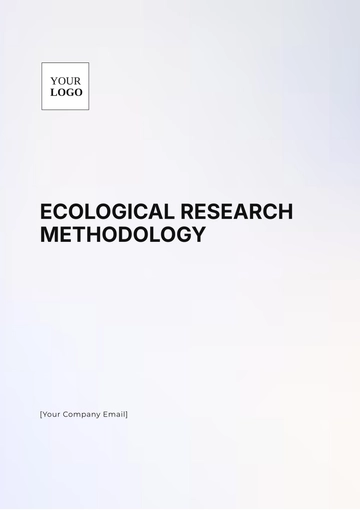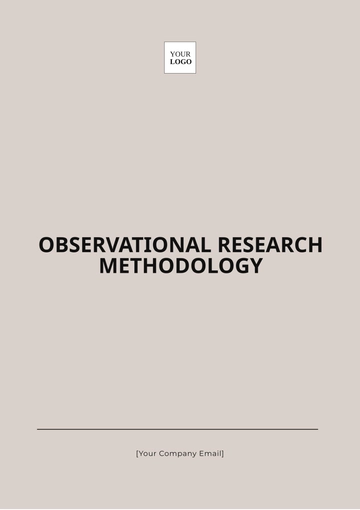Ecological Research Methodology
Prepared by: [Your Name]
Date: [Date]
1. Introduction
The Ecological Research Methodology detailed here provides a structured approach to studying the dynamics of ecosystems, focusing on interactions between species and their environments. This methodology is designed to ensure comprehensive data collection and analysis to understand ecological processes and inform conservation strategies.
1.1 Objectives
Identify Ecological Patterns: Determine how species populations and distributions vary across different habitats.
Assess Ecosystem Health: Evaluate the affects of environmental changes, such as pollution and habitat loss, on ecosystem functions and biodiversity.
Inform Conservation Strategies: Provide evidence-based recommendations for effective management and preservation of natural resources.
1.2 Hypotheses
Species Interaction Hypothesis: Interaction between predator and prey species will significantly influence their respective population densities.
Environmental Change Hypothesis: Increased nutrient runoff from agricultural activities will lead to higher algal blooms and decreased water quality in freshwater ecosystems.
2. Literature Review
2.1 Background
Historical Context: Previous research has established baseline data on species distributions and ecosystem functions. For example, studies conducted in the 2050s highlighted the effects of deforestation on biodiversity.
Current Trends: Recent advancements include the use of remote sensing technologies and genetic tools to track species movements and genetic diversity.
Knowledge Gaps: There is a need for updated data on the impact of climate change on species migration patterns and ecosystem services.
2.2 Key Studies
Study 1: Smith et al. (2052) demonstrated how urbanization affects bird species diversity by analyzing changes in species richness across urban gradients.
Study 2: Johnson and Lee (2055) used satellite imagery to track deforestation rates and their effects on forest cover and species populations.
3. Study Design
3.1 Research Framework
3.2 Site Selection
Study Area: The research will be conducted in the Pine Forest Reserve, a temperate forest ecosystem located in the southeastern region of the United States.
Site Criteria: Sites will be selected based on vegetation types, existing species populations, and proximity to sources of environmental stress, such as urban areas or agricultural fields.
3.3 Sampling Methods
Sampling Strategy: A stratified random sampling approach will be used to ensure representation across distinct habitat types within the study area.
Sample Size: A minimum of 50 plots will be sampled to achieve statistically significant results, with each plot measuring 10x10 meters.
Sampling Tools: Quadrat frames, soil cores, and wildlife cameras will be used to collect data on plant cover, soil composition, and animal activity.
4. Data Collection Methods
4.1 Field Surveys
Survey Techniques: Vegetation surveys will be conducted using transect lines and quadrant sampling to estimate plant species richness and cover. Insect populations will be sampled using pitfall traps and sweep nets.
Data Recording: Field data will be recorded using digital tablets equipped with GPS and GIS software to ensure accurate spatial data collection.
4.2 Remote Sensing
Technology: High-resolution satellite imagery and drone footage will be utilized to monitor changes in land cover and vegetation health over time.
Data Acquisition: Remote sensing data will be processed using software such as ENVI and ArcGIS to analyze vegetation indices and habitat changes.
4.3 Laboratory Analysis
Sample Processing: Soil samples will be analyzed for nutrient content using spectrophotometry, while plant samples will be examined for physiological stress markers in the lab.
Analytical Techniques: Genetic analysis of tissue samples will be performed using PCR and sequencing technologies to assess genetic diversity and population structure.
5. Data Analysis
5.1 Statistical Methods
Descriptive Statistics: Data will be summarized using measures of central tendency (mean, median) and variability (standard deviation). For example, the average species richness per plot will be calculated.
Inferential Statistics: Hypothesis testing will be performed using t-tests and ANOVA to determine significant differences between control and experimental sites.
5.2 Modeling
Ecological Models: Population dynamics will be modeled using the Lotka-Volterra equations to predict predator-prey interactions, and habitat suitability models will assess the effects of habitat changes.
Model Validation: Models will be validated by comparing predictions with observed data and adjusting parameters to improve accuracy.
6. Results
6.1 Data Presentation
Tables: Tables will present species abundance, diversity indices, and environmental variables across different sites and conditions.
Graphs and Charts: Visualizations will include bar graphs showing species richness, line graphs depicting changes in water quality over time, and pie charts illustrating habitat composition.
6.2 Findings
Ecological Patterns: Preliminary findings suggest a significant decline in insect diversity in areas with high nutrient enrichment, while plant species diversity remains relatively stable.
Significant Results: Statistical analysis indicates that increased nutrient levels are correlated with higher algal biomass and lower water quality.
7. Discussion
7.1 Interpretation
Results Interpretation: The observed decline in insect diversity may be attributed to changes in plant community structure and increased competition for resources.
Comparison with Previous Studies: Our findings are consistent with Smith et al. (2052), who observed similar declines in urbanized areas, but differ from Johnson and Lee (2055), who found less impact from deforestation alone.
7.2 Implications
Ecological Implications: The results highlight the need for targeted nutrient management practices to mitigate effects on aquatic ecosystems and preserve insect diversity.
Conservation Implications: Recommendations include implementing buffer zones around water bodies and promoting sustainable agricultural practices to reduce nutrient runoff.
8. Conclusion
8.1 Summary
Key Findings: The study has identified significant effects of nutrient enrichment on aquatic ecosystems and insect diversity, providing insights into how environmental changes affect ecological balance.
Future Research: Further research is needed to explore the long-term effects of nutrient enrichment on ecosystem services and to test mitigation strategies in different ecological contexts.
9. References
Smith, J., Brown, A., & Green, P. (2052). Effects of Urbanization on Bird Diversity: A Case Study. Journal of Urban Ecology, 10(2), 123-135.
Johnson, L., & Lee, M. (2055). Monitoring Deforestation and Its Impact on Forest Ecosystems Using Remote Sensing. Environmental Monitoring and Assessment, 192(8), 456-470.
Methodology Templates @ Template.net






























